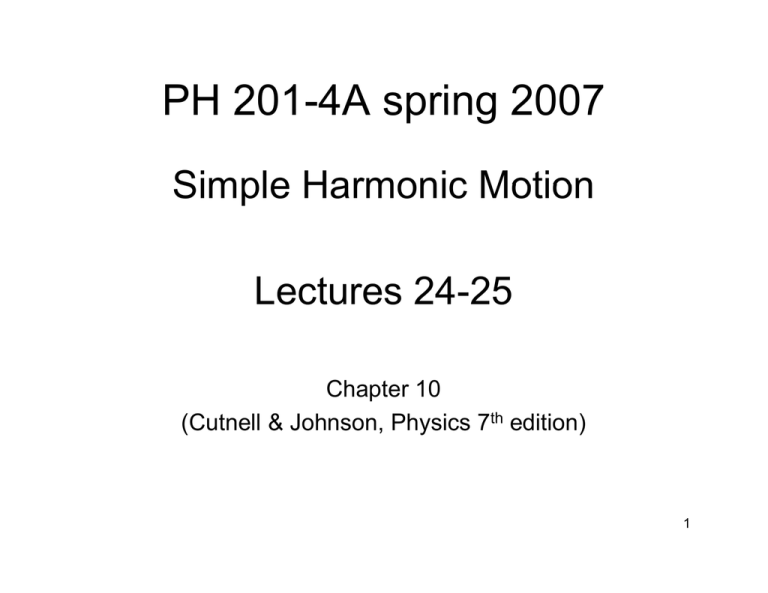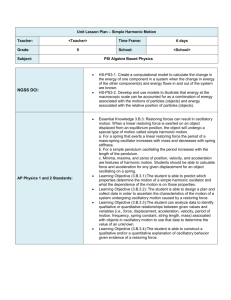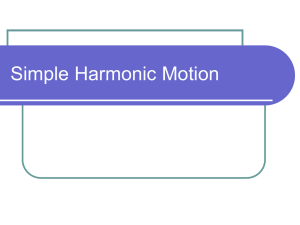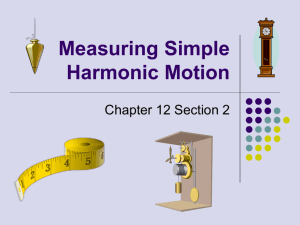PH 201-4A spring 2007 PH 201 4A spring 2007 Simple Harmonic Motion
advertisement

PH 201-4A 201 4A spring 2007 Simple Harmonic Motion Lectures 24-25 Chapter 10 (Cutnell & Johnson, Physics 7th edition) 1 The Ideal Spring Springs are objects that exhibit elastic behavior. It will return back to its original length after being stretched or compressed. Equilibrium position Relaxed or unstrained length of the spring For small deformations, the force “F” required to stretch or compress a spring obeys the equation: F = kx • x - displacement of the spring from its unstrained length • k – spring p g constant [[N/m]] unit • A spring that behaves according to the relationship F = kx it is said to be an ideal spring 2 Restoring Force Equilibrium q position p Restoring force Stretched position • To stretch or compress a spring a force F must be applied • Newton’s 3rd Law: Every action has an equal in magnitude and opposite reaction. The reaction force that is applied by the spring to the agent that does the pulling or pushing is called restoring force Hooke’s Law: F = -kx F = restoring force k = spring constant x = displacement from unstrained length The restoring force is always opposite to the displacement of the spring 3 Problem 9: A 10.1 kg uniform board is wedged into a corner and held by a spring at 50.0° angle, as the drawing shows. The spring has a spring constant of 176 N/m and is parallel to the floor. Find the amount by which the spring is stretched from its unstrained length. 4 An object is attached to the lower end of a 100-coil spring that is hanging from the ceiling. The spring stretches by 0.160 m. The spring is then cut into two identical springs of 50 coils each. As the drawing shows, each spring is attached between the ceiling and th object. the bj t By B how h much h does d each h spring i stretch? t t h? 5 When an object attached to a horizontal spring is moved from its equilibrium position and released, the restoring force F = -kx leads to simple harmonic motion Moving strip of paper at a steady rate Record position of the vibrating object vs. time pen A = amplitude – the maximum displacement from equilibrium x = 0 is the equilibrium position of the object. Position as a function of time has the shape of trigonometric sine or cosine function 6 Oscillations Periodic motion – the motion of a particle or a system of particles is periodic, or cyclic, if it repeats again and again at regular intervals of time. Example: • The orbital motion of a planet • The uniform rotational motion of a phonograph turntable • Back and forth motion of a piston in an automobile engine • Vibrations of a guitar string Oscillation – back and forth or swinging periodic motion is called an oscillation Simple Harmonic Motion • Simple p harmonic motion is a special p kind of one dimensional periodic p motion • The particle moves back and forth along a straight line, repeating the same motion again and again Simple p harmonic motion – the p particles position p can be expressed p as a cosine or a sine function of time. Cosines and sines are called harmonic functions => we call motion of the particle harmonic. 7 The motion of a mass oscillating back and forth in response to the push and pull of a spring – simple harmonic The motion Th ti off a pendulum d l iis approximately simple harmonic midpoint turning point of the motion x = xmin or xmax A – amplitude of the motion the distance between the midpoint (x = 0) and either of the turning points (x = +A; x = -A) A) ω – angular frequency [rad/sec] ωt – “angle” [rad] 8 Special Geometrical Relationship Between Simple Harmonic Motion and Uniform Circular Motion Reference circle Simple Si l mechanism h i for f generating ti simple i l harmonic h i motion from uniform circular motion. A slotted arm placed over a peg which is attached t a wheel to h l in i uniform if circular i l motion. ti The slot is vertical and the arm is constrained to move the horizontal peg – “satellite” midpoint of th slot the l t in i the th arm – “particle” “ ti l ” 1) Particle – SHM x = cos(ωt) 2) Satellite particle in uniform circular motion with angular velocity “ω” along a circle radius “A” centered at midpoint θ = ωt xsat = Acosθ = Acos(ωt) Xsat always coincides with the x coordinate of the particle. They have exactly the same x motion. 9 The Instantaneous Acceleration in Simple Harmonic Motion The instantaneous acceleration of a particle in simple harmonic motion is proportional to the instantaneous distance x, but is in the opposite direction. 10 The Speed of Simple Harmonic Motion The velocity of the mass attached to the end of the spring can be found with the help of the reference circle circle. Satellite particle p ωs = ωp = ω R=A The point S moves with the tangential velocity Vt. The x component of this velocity is the velocity of the point P and => the velocity of the mass m 11 Kinematic Equations for Simple Harmonic Motion 12 The Simple Harmonic Oscillator Consists of a mass coupled to an ideal, massless spring which obeys Hook’s Law. F = -kx After positive displacement of the mass the spring i pulls ll the th mass back b k toward t d the th equilibrium position – the relaxed length of the spring. The mass overshoots the equilibrium position. Mass attached to a spring sliding back and forth on a frictionless surface ma = -kx ; a = -ω2x Th equations The ti become b identical id ti l if 2 ω = k/m ω = √k/m frequency = ω/2π = 1/2π√k/m ; T = 1/freq = 2π√m/k Isochronism – frequency of the oscillator is the same, regardless of the amplitude -mω2x = -kx k ω2 = k/m k/ 13 Problem 90: When an object of mass m1 is hung on a vertical spring and set into vertical simple harmonic motion, its frequency is 12.0 Hz. When another object of mass m2 is hung on the spring along with m1, the frequency of the motion is 4.00 Hz. Find the ratio m2/m / 1 off th the masses. 14 Three springs with force constants k1 = 10.0 N/m, k2 = 12.5 N/m, and k3 = 15.0 N/m are connected in parallel to a mass of 0.500 kg. The mass is then pulled to the right and released. Find the period of the motion. 15 A mass of 0.300 kg is placed on a vertical spring and the spring stretches by 10.0 cm. It is then pulled down an additional 5.00 cm and then released. Find: a) K; b) ω; c) frequency; d) T; e) max velocity; f) amax; g)) Fmax (max ( restoring t i force); f ) h) V for f x = 2.00 2 00 cm; i) The equations for displacement, velocity and acceleration at any time 16 17 Energy and Simple Harmonic Motion. Elastic Potential Energy. • Energy is the capacity of the object to do work • A spring has potential energy when it is stretched or compressed and can do work on an object that is attached to the spring. (elastic potential energy) • When the object attached to one end of a stretched spring is released, the spring pulls the object from its initial position x0 to its final position xf. • The work done by a constant force W = (Fcosθ)s • s = x0 – xf magnitude of the displacement • Force has changing magnitude because the dependence of the spring force on x is linear Fav = ½(kx0 + kxf) • Welast done by the average spring force Wel = (Fcosθ)s = ½(kx0 + kxf)cos0°(x0 – xf) = 1/2kx02 – 1/2kxf2 The elastic potential energy PEelastic = U is the energy that the spring has by virtue of being stretched or compressed. PEelastic = 1/2kx2 18 Conservation of Energy for the Simple Harmonic Oscillator The force exerted by a spring is a conservative force. External nonconservative forces (friction) do no net work 19 20 21 The Simple Pendulum A simple pendulum consists of a bob suspended by a string or a rod rod. String is massless bob – m Gravity provides restoring force 22 The Simple Pendulum A simple pendulum is a bob that is attached to a string and allowed to oscillate. The bob is assumed to behave like a p particle of mass “m”, and the string g is massless. Restoring force = -mgsinθ mgsinθ Apply 2nd Newton’s Law: F = ma => -mgsinθ = ma => The tangential acceleration of the bob is: a = -gsinθ 23 For simple harmonic motion of a spring the acceleration was found to be Use the equations developed for the vibrating spring to describe the motion of the pendulum. Example 1: The pendulum can be used as a very simple device to measure the acceleration of gravity at a particular location. • measure the length “l” of the pendulum and then set the pendulum into motion • measure “T” by a clock • 24 Example 2: The Length of a Pendulum. A student is in an empty room. He has a piece of rope, a small bob, and a clock. Find the volume of the room. 1. 2. 3. 4. From the piece of rope and a bob we make a simple pendulum We set pendulum into motion We measure p period “T” by y a clock We calculate the length of the pendulum (rope) 5. With a help of the rope of the known length we measure the dimensions of the room a x b x h and its volume V = a x b x h 25 Damped Harmonic Motion • In simple harmonic motion an object oscillates with a constant amplitude because there is no mechanism for dissipating energy. energy • In practice, oscillating mechanical systems lose energy in a variety of ways via friction and the amplitude of oscillation decreases as time passes until motion gradually dies away. • The decrease of amplitude is called damping and the motion is called damped harmonic motion. • Example: Suspension system of an automobile uses shock absorbers. When the piston moves in response to a bump in the road, holes in the piston head permit the piston to pass through the oil oil. Viscous forces that arise during this movement cause the damping. • The smallest degree of damping that completely eliminates the oscillations critical damping. • When damping exceeds critical value – motion over damped • When damping is less than critical value, the motion is under damped. 26 Driven Harmonic Motion and Resonance • To set an object on an ideal spring into simple harmonic motion we must apply a force that stretches or compresses the spring initially. • Suppose that this force is applied at all times, not just for a brief initial moment. We push h and d pull ll the th ball b ll back b k and d forth. f th • The resultant motion is driven harmonic motion because the additional force controls or drives the behavior of the object. • The frequency at which the spring system naturally oscillates is called natural frequency. • When fdr = fn resonance will occur. • Resonance is the condition in which a time dependent force can transmit large amounts of energy to an oscillating object (driving force has the same direction as velocity) leading to a large amplitude motion. 27






